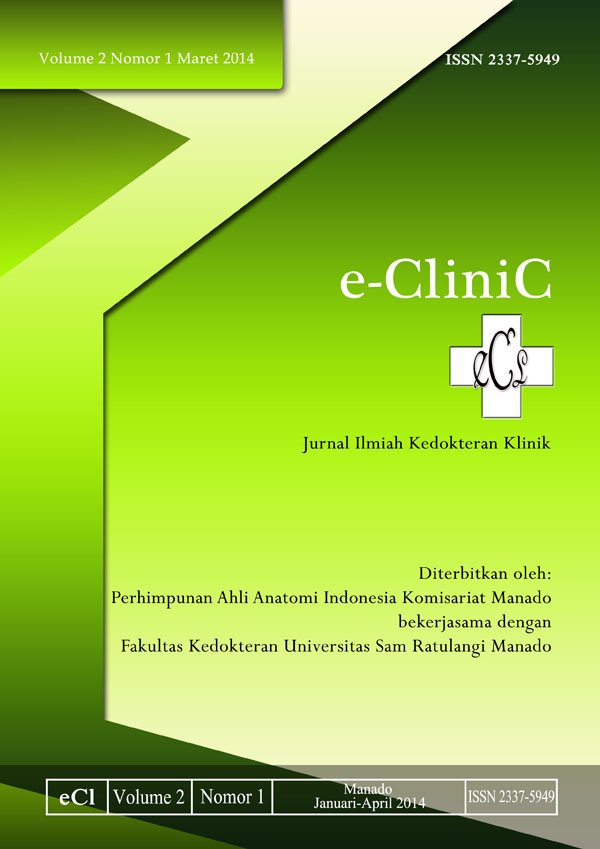HUBUNGAN TROMBOSITOPENIA DAN HEMATOKRIT DENGAN MANIFESTASI PERDARAHAN PADA PENDERITA DEMAM DENGUE DAN DEMAM BERDARAH DENGUE
DOI:
https://doi.org/10.35790/ecl.v2i1.3610Abstract
Abstract: Dengue fever (DF) and dengue haemorrhagic fever (DHF), an infection disease who still become a health problem in Indonesia. There was increasing cases reported in Indonesia from 2011 to 2012. Thrombocytopenia and plasma leakage signed by haemoconcentration are important indicator in dengue. Bleeding manifestation appears as clinical symptom of DF and DHF that increases mortality ratio of dengue infection. The aim of this study is toinvestigatethe correlation of thrombocytopenia and hematocrit tobleeding manifestation of dengue fever and dengue haemorrhagic fever.This study is retrospective cross-sectional. Forty two men and thirty five women were evaluated in this study, fifty nine of them were diagnosedas DF and eighteen of them were diagnosed asDHF. The correlation of thrombocytes to hematocrit used nonparametric Spearman test, the result were significant with p=0,000 and r=-0,183. The correlation of thrombocytes to the occurrence of bleeding manifestation and hematocrit to the occurrence of bleeding manifestation, both were not significant, with p=0,714 and p=0,153. This study suggest that there were a very weak correlation between thrombocytes and hematocrit and no correlation between thrombocytopenia and hematocrit with bleeding manifestation.
Keywords: Dengue Fever, Dengue Haemorrhagic Fever, Thrombocytopenia, Hematocrit, and Bleeding Manifestation.
Â
Â
Abstrak: Demam dengue (DD) dan demam berdarah dengue (DBD) merupakan penyakit infeksi yang masih menjadi masalah kesehatan di Indonesia. Telah dilaporkan terdapat peningkatan jumlah kasus di Indonesiadari tahun 2011 ke tahun 2012. Berdasarkan kriteria laboratorium WHO, jumlah trombosit yang rendah (trombositopenia) dan kebocoran plasma yang ditandai dengan hemokosentrasi merupakan indikator penting pada DD dan DBD. Gejala klinis DD dan DBD dapat disertai dengan manifestasi perdarahan yang akan meningkatkan rasio mortalitas penderita infeksi dengue. Penelitian yang bertujuan untuk mengetahui hubungan trombositopenia dan hematokrit dengan manifestasi perdarahan pada penderita demam dengue dan demam berdarah dengue ini menggunakanmetode retrospektif dengan studi cross-sectional.Sampel pada penelitian ini terdiri dari 42 orang laki-laki dan 35 orang perempuan. Penderita DD berjumlah 59 orang dan penderita DBD berjumlah 18 orang. Uji nonparametrik Spearman terhadap trombosit dan hematokrit mendapat hasil signifikan (p=0,000 ; r=-0,183). Uji nonparametrik Spearman terhadap trombosit dan manifestasi perdarahan mendapat hasil yang tidak signifikan (p=0,714). Uji nonparametrik Spearman terhadap hematokrit dan manifestasi perdarahan mendapat hasil yang tidak signifikan (p=0,153). Dapat disimpulkan bahwa terdapat korelasi yang sangat lemah antara trombosit dan hematokrit, tidak terdapat hubungan yang bermakna antara trombositopenia dan hematokrit dengan manifestasi perdarahan.
Kata kunci:Demam Dengue, Demam Berdarah Dengue, Trombositopenia, Hematokrit, dan Manifestasi Perdarahan.
Downloads
How to Cite
Issue
Section
License
COPYRIGHT
Authors who publish with this journal agree to the following terms:
Authors hold their copyright and grant this journal the privilege of first publication, with the work simultaneously licensed under a Creative Commons Attribution License that permits others to impart the work with an acknowledgment of the work's origin and initial publication by this journal.
Authors can enter into separate or additional contractual arrangements for the non-exclusive distribution of the journal's published version of the work (for example, post it to an institutional repository or publish it in a book), with an acknowledgment of its underlying publication in this journal.
Authors are permitted and encouraged to post their work online (for example, in institutional repositories or on their website) as it can lead to productive exchanges, as well as earlier and greater citation of the published work (See The Effect of Open Access).







